Sportboat Buying: 10 Check Points, Part 2
Most repeat boat buyers know that new boat dealers often direct them to a boat that's in stock, rather than one that specifically meets the customer's needs or the one they walked into the showroom to see. Because of the Great Recession nearly all boat dealers are carrying far fewer boats in inventory than ever before. That's why you need to figure out before you get into the showroom how much horsepower and which brand engine you want in your new boat.
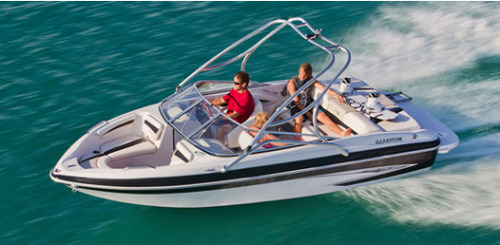 Selecting the brand of boat is only half the sportboat-buying exercise. The engine selection, both in terms of brand and horsepower, are also critical -- maybe even more so. Then, there is the lower unit to think about. |
Check Point #2: Engine Horsepower and Engine Selection
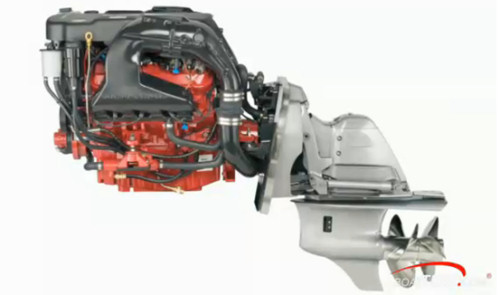 The displacement of sterndrive diesel engines ranges from 3.0 L to 8.2 L. |
A. Match Horsepower to Your Application
The engine is the most important component in your boat. Some people think the right engine and drive unit are even more important than the brand of boat itself. Indeed, many owners report that the only real trouble they have with their boat involves the engine. Also, if the engine selected cannot meet the requirements of the mission of the owner, then the boat's performance will be disappointing.
Engines are expensive and for that reason it is important that consumers know how much power and torque are needed for the intended application.
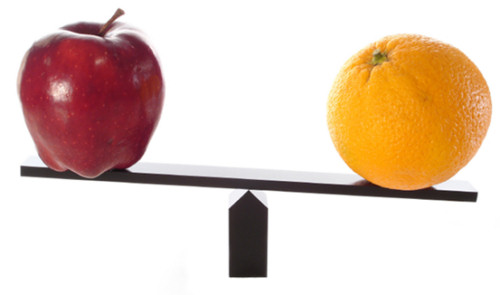 |
B. Compare Boats with the Same Engine Horsepower
When comparing boats make sure you are comparing apples-to-apples when it comes to the engines. Each boat builder has its own "target market" for each model it builds and do not necessarily equipment the same size boats with the same horsepower. However, most builders offer options in horsepower selection so consumers can usually compare boat pricing apples-to-apples as far as the engines are concerned.
Engine companies generally know what their competitors are charging builders for like products and as a result their pricing tends to be competitive for the base engine. However, do not assume that all builders have the same charge for the engines they install. Every builder has its own pricing policy and strategy for both engines and high-tech add-ons.
 |
C. Engine Brand Selection
Corporate cultures, testing procedures, design and engineering, warranties and the customer service of engine makers are not all the same. We urge consumers to find out as much as they can about the engine models contemplated. Read the fine print of the warranty and compare them just as you would the warranties of the boat brands you are considering.
Be advised that many boat brands owned by the Brunswick Corp. offer only engines built by its divisions and affiliates, with only a few exceptions. Other boat builders also often have exclusive arrangements with certain engine brands for a variety of reasons. In all cases consumers should inquire from the dealer what engines are available for any boat model.
Sterndrive Engines. Virtually all sterndrive boats built in the U.S., and most in the world, are powered by either Volvo Penta or MerCruiser. Service should be the decisive factor when comparing engines of the same horsepower from the two engine brands, electronic upgrades notwithstanding. Mercury Marine now has a suite of electronic products that should be considered.
Mercury is in the process of discontinuing its 3.0 L engine and its 4.3 L and 4.5 L engines are recommended.
Perhaps the greatest advantage of sterndrive boats is the size of their swim platform which extends across the stern of the boat providing a large staging area for launching watersports.
While the basic blocks are essentially the same, the marinization procedures, equipment, materials, and systems added to the block by Volvo Penta and MerCruiser are not the same, and consumers would be wise to investigate the relative merits of both brands before buying. There are some important differences between the brands. Check out BoatTEST’s reports and videos on these engine in the “Engine Section.” Horsepower ranges from 200 to 430.
Boaters planning to be involved with towing sports with many people aboard would be well-advised to opt for the largest engine available for any given model.
Mercury makes a 4.5L engine and an 8.2 L engine that Volvo Penta does not have available.
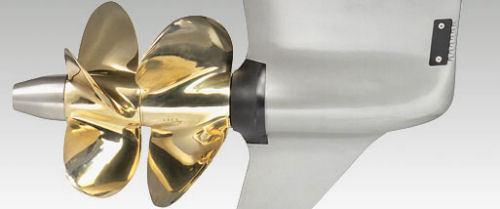 The Duoprop was invented by Volvo Penta, followed a couple years later by MerCruiser’s Bravo III. |
Outboard Engines. There are five major outboard engine brands on the market: Evinrude, Honda, Mercury, Suzuki, and Yamaha. Horsepower ranges from 2-hp to 350-hp. Outboard engines also come in both 2-stroke and 4-stroke versions. Evinrude makes only a 2-stroke engine, while the other four brands make 4-stroke engines. Mercury and Yamaha offer both 2-stroke and 4-stroke outboards. Honda and Suzuki offer only 4-stroke motors.
2-stroke outboard engines have more lower-end torque than do 4-stroke engines. That means that they are generally better able to get skiers and wakeboarders up on their boards quicker than a boat powered with a 4-stroke engine.
At one time 4-stroke engines were more fuel efficient than most 2-stroke engines, but that distinction has largely been eliminated by high-tech advancements in 2-stroke engines and today other considerations usually weigh more heavily on model selection.
Perhaps the greatest drawback to outboard power of sport boats is the absence of one wide swim platform from which to launch watersports.
Diesel Engines. There are numerous diesel engine brands on the marine market. Most of these are marinized versions of commercial engines. Because of their weight and expense, diesel engines are not often used to power sportboats except in Europe where gasoline prices are high. While diesel prices are usually lower in Europe, the money saved on the purchase price of the boat is rarely compensated for in fuel-efficiency over the average ownership period.
Gas Inboard Engines. Gas inboard engines with conventional straight shafts are used extensively in specialized ski boats and in cruising boats in the 30' to 45' range, as well as in some specialized applications. There are several companies that marinize the same blocks used in sterndrive engines. Each marinizing company has its own unique approach to that process and consumers should educate themselves on the features and benefits of the brands and models available.
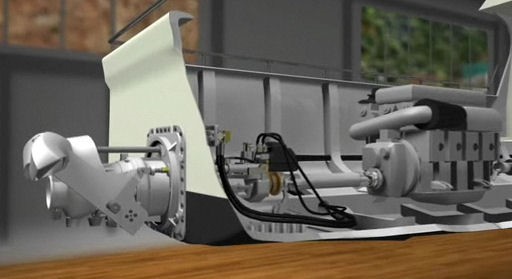 This is a CAD conceptual image of a jet drive installation. Water is sucked in through the bottom of the boat and shot out from a nozzle in the stern. |
Jet Drives. Sportboats powered by “jet drives” -- which are actually water pumps – have several advantages, the most obvious of which is the absence of an exposed propeller. First used in PWCs, these drive units have now been used for many years in sportboats with outstanding success. There are negatives to the concept, such as the engines are always in gear and it is the bucket design that drops down and diverts the water flow that makes them go in reverse and stay neutral, or relatively so. At one time they were hard to dock, but new designs for both the engine makers have greatly improved handling around the dock.
Yamaha Jet drive systems are used exclusively in Yamaha sportboats. Rotax (a division of BRP, the maker of Evinrude engines) jet drives are used in sportboats made by Chaparral and Scarab.
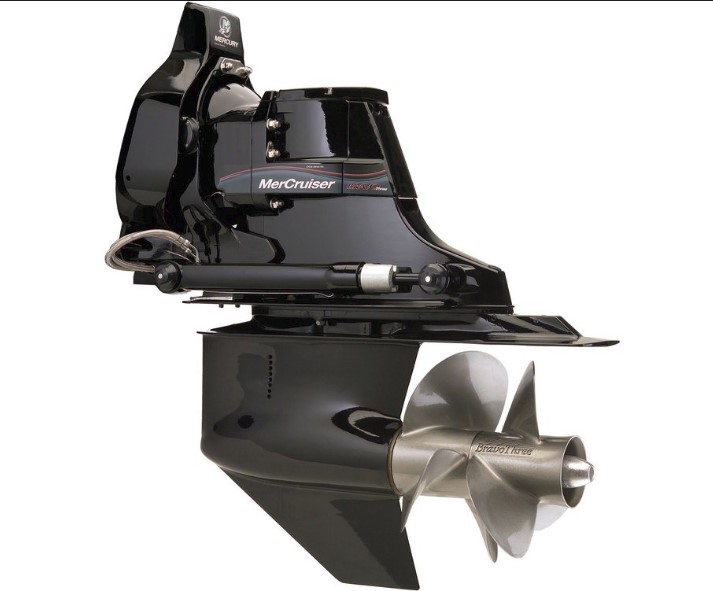 Mercury Marine’s Bravo III dual-prop design is a popular choice. |
D. Lower Unit Selection
Sterndrive Lower Units. The lower units offered by both Volvo Penta and MerCruiser come in several different configurations in both single and dual-prop drives. Like the engines, it is important to match the lower unit type and design to your application. Your boat dealer is best equipped to do that for you. Again, when comparing pricing make sure it is apples-to-apples on the lower unit as well. Sterndrive propulsion is usually more efficient than straight-shaft inboard propulsion.
Sterndrives models are available for both gas and diesel engines.
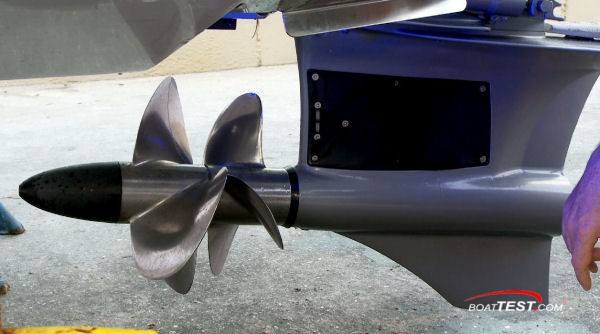 The Volvo Penta Forward Drive places the props 26” farther forward that conventional sterndrives. |
Forward-Facing Sterndrives. Volvo Penta makes what it calls the “Forward Drive” which has forward-facing Duoprops which place the props 26” forward of where they would be on the standard sterndrive lower unit. For this reason, and because the lower units is between a boarding enthusiast and the props, several builders are promoting these boats for wake surfing. The downside to this engine is that the prop cannot be tilted out of the water, and if it hits an obstruction the props can become damaged, whereas with aft-facing props the lower unit will usually bounce up, possibly saving the props.
E. Sterndrive Prop Selection
Both Mercury and Volvo Penta offer a number of propping options. The boat builder knows the best options for any given boat it builds and consumers are advised to follow the advice of their dealers. The dual-prop units made by both companies are more expensive because of the added gearing and props, so are they worth the money?
Dual-prop powered boats track straighter at low speeds and are also somewhat easier to dock because there is no “side walking” in the direction of the rotation. This is less of an issue with dual engine installations. Dual-props come in “sets” and are not as easy to change out as single props.
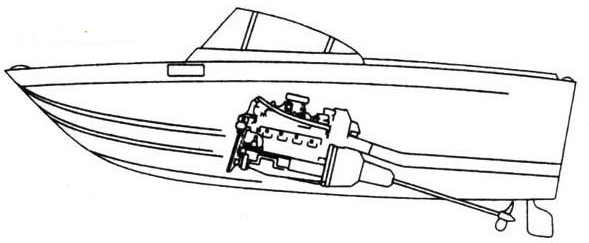 Because the prop is under the boat they are safer than many other options, but they are harder to dock. |
Straight Shaft. There was a time when virtually all sportboats were inboard-powered. Then came outboards, much later came sterndrives. Today, straight shafts are mostly used in specialized sportboats for towing sports. These boats are almost all made for use in protected water and are intended for tournament activities, with some exceptions. Sea Ray has recently introduced an inboard boat for towing sports and for general sportboat usage.
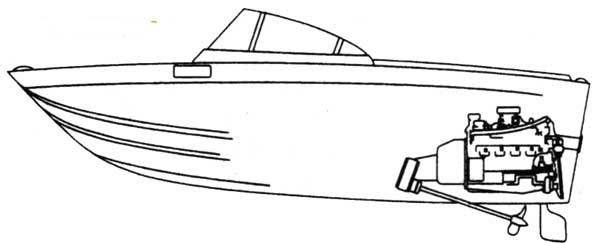 By moving the engine to the stern of the boat interior space forward is made available. |
V-Drives. These drives are a variation of a straight-shaft design. The difference is that the engines (both gas and diesel) have their fly wheel facing forward and are coupled with a V-drive marine gear that permits an aft-facing shaft. Current generations of V-drives have proved reliable and we are told by the engine makers that only about 5% of the engine's horsepower is lost in the gearing.
Observations
There are more choices now than ever before for powering sportboats. We suggest that consumers think carefully about their application and the loads the boat will be expected to carry. All small boats are very weight sensitive. Those involved with towing sports with lots of people aboard should consider powerplants with high torque in the low RPM ranges, or higher horsepower engines. Those who want top speed should go for both high horsepower and careful prop selection. In our testing we generally see higher WOT speeds for sportboats powered by outboards vs. sterndrive-powered boats of about the same horsepower.
Next Week: Buying Check List #3